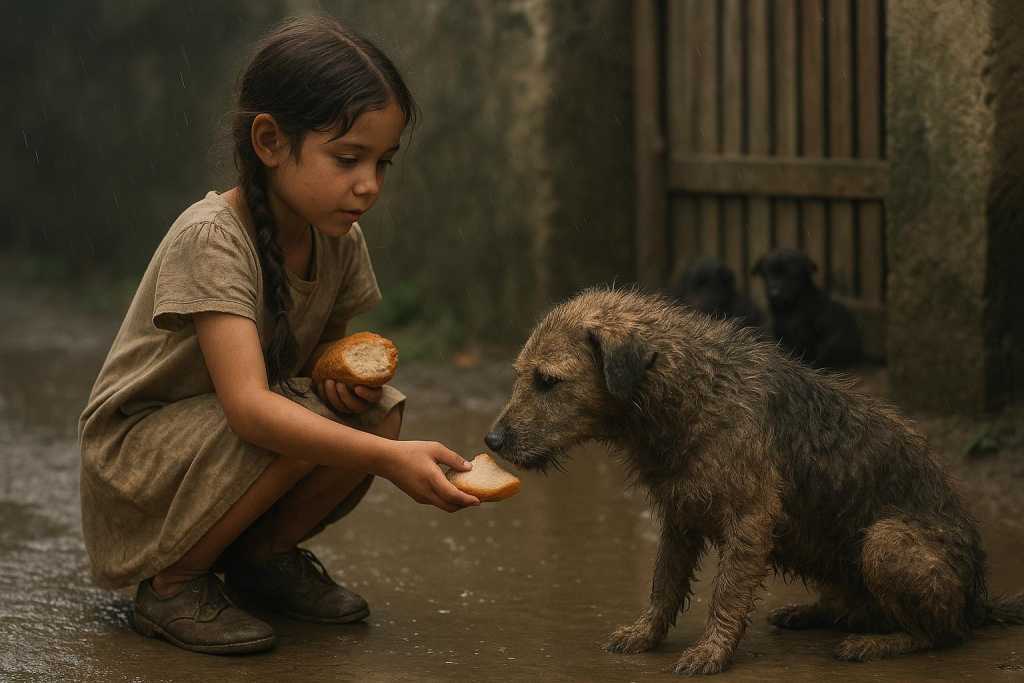She Gave Him the Last Piece of Bread — He Was a Street Dog Covered in Mud
There are moments in life when a simple gesture—a scrap of bread, a kind glance, a hesitant offering—can ripple into something greater than you ever imagined. This is one such story.
The Unexpected Arrival
One evening, as dusk settled over the quiet neighborhood, she spotted something unusual in the dim light. Amid the shadows and the flicker of street lamps, a stray dog appeared, its coat caked in mud and grime, its ribs faintly visible. He moved slowly, as though every step was a burden. Mud clung to his paws, his ears drooped, and his eyes held a weariness that told of many hard days on the streets.
She froze for a moment, heart heavy. Many passersby would turn away; some would glance but not stop. But she took a step forward. Something inside urged her to stay.
The Last Piece of Bread
That night, as she returned home, she realized she had no extra food to spare—nothing fancy, nothing elaborate. But she had one thin slice of bread. As she held it in her hand, she hesitated. But the dog remained just on the outskirts, watching her with hopeful eyes.

She knelt down and offered it. Her hands trembled slightly—not from fear, but from compassion. The dog sniffed, then slowly accepted the bread, breaking off the piece gently with trembling jaws. He ate it with a quiet hunger, as though he had not tasted food in days. She watched him, holding her breath.
After that first bite, she stayed by his side. She offered water, a calm presence, soft words. Over time, he softened. The mud gradually turned to patches on fur; his cautious watchfulness gave way to a tentative trust.
Earning His Trust
In the days that followed, she began to leave small portions of food in familiar spots, evening after evening. The dog appeared again and again, always wary at first, retreating if approached too quickly. But she waited. Day by day, she moved closer—quietly, patiently, respectfully.
At first, he would not allow her to touch him. Her approach would scare him off. But she persisted. She lowered her voice, kept her body language relaxed, offered food with open hands. She spoke gently. She never forced him. Gradually, inch by inch, he let her draw near.
And one evening, under the soft glow of streetlights, he took a piece of bread from her hand while she sat just a few feet away. He paused, looked up, then walked away slowly. But he came back. The next night he stayed longer. Soon he began to linger, sit nearby, even wag a tail.
Healing, Inside and Out
Over the weeks, she noticed small changes. The dog’s coat, once matted and dull, began to shine in patches. His eyes regained some brightness. His body filled out a little. But more than that, his demeanor changed: less fearful, more curious, more open to human presence.
She started wrapping him in a blanket when the nights grew cold, providing shade when the sun beat down. She cleaned his wounds, fed him proper meals, talked to him, offered companionship even when he was silent. She named him—because once you name a being, you recognize their worth.
He became part of her daily routine. She would check for him at dawn, leave water and food, and if he was not there, worry would claw at her until she saw him again. On her days off, she’d walk with him down quiet alleys, let him explore grassy stretches, feel the wind through his fur.
Neighbors began to notice. Some would slow their cars when they saw the pair; others would whisper, “Isn’t that the stray she’s been feeding?” Some offered help—old blankets, extra food, even a treat. But she asked for little. The journey, she knew, had to be gradual, respectful, trust-based.
A Transformation Beyond Appearance
Over months, the change in the dog mirrored a shift in her own heart. She saw in him not just a street animal, but a partner in life’s small adventures. When he slept at her doorstep at night—finally safe and warm—she felt a quiet, steady pride.
He went from scrounging in gutters to wagging a tail at the sound of her footsteps. He went from fearful cowering to leaning into her hand for a caress. He learned that his world no longer revolved around survival—but around connection, care, and safety.
In return, she learned patience, empathy, and the quiet power of consistency. She realized how often we overlook the suffering that lingers at the margins, because it moves slowly, in silence, mud, and fear. But even in that slow movement, there is room for change.